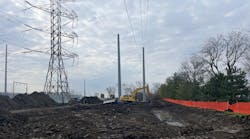My first contact with the heady world of advancing technology in our industry happened early in my career. Around 1980, a company named Gould Brown Boveri came to the utility where I was working with a new power circuit breaker technology that used something called sulfur hexafluoride (SF6). The company claimed it could switch shunt capacitor banks faster and safer than anything on the market, but it needed a utility to field test the technology.
I didn't have any better sense and volunteered to work with the manufacturer — once again, running toward that which others ran from. I went to the factory, met the company's engineering team and worked closely with them for more than a year. Finally, the breaker was installed on a large shunt capacitor bank and put through its paces for an extremely hot summer.
Nothing blew up and there were no operational issues. It was the first of many projects I was fortunate enough to be involved with that introduced a new technology to the grid. I was hooked. From that point onward, I was a card-carrying technology junkie. As the old saying goes, “Unless you're the lead dog, the view is always the same!”
So, when Rick Bush, T&D World editorial director, told me my next assignment would be a look at the technological advancements shaping our electrical substation future, I got excited. Heck, I was more than excited, I was elated.
Over the years, T&D World has sent me to the U.S. labs testing new technological concepts. I have toured manufacturers' facilities developing the latest technology applications. I also have visited the utilities installing many of the first deployments of the new technologies on their networks. It has been stimulating and exciting, but it was personal this time.
Special Interest
When I worked for a Southwest utility, anything high tech and substation related ended up in my office. As a consulting engineer, nothing has changed. I am still looking for applications with an edge. One of the coolest substation technologies I have used lately is terrestrial light detection and ranging (LiDAR). My client wanted to expand a 40-plus-year-old substation but did not have any detailed drawings.
Back in the day, developing a drawing set would have been a big project in itself. It would have taken months and a ton of labor hours to accomplish. With ground-based LiDAR, it took a couple of hours to scan the entire substation, and a week or so to turn the raw data into a detailed 3-D model of the substation for generating interactive plans and profiles of the station.
When the 3-D model was delivered to the client, the utility's engineers were able to take a virtual walk through the substation. They could stop at equipment, take measurements, check clearances and identify points needing more investigation.
While we were at it, we did a complete survey of the substation and the surrounding area for the expansion. With this technology, this functionality is put into the trained hands of a skilled operator. The survey took about an hour more on site and a few more hours on the computer. When it was finished, we had a topographical map of the site that could generate 3-D models of the topography of the site. Yes, I'm hooked on technology. And why not? It makes us more efficient and effective if we let it.
Believe It
Advancements in software, design tools and processes are exciting, but there is real magic taking place in the electrical apparatus being deployed in the substation. Manufacturers are bringing all manner of new adaptations of the tried-and-true devices as materials science matures and allows for more efficient designs.
We are seeing research into solid-state transformers and circuit breakers using power electronics. The insulating medium used inside apparatus is changing. We can buy transformers insulated with vegetable oil instead of mineral oil. SF6 gas is being replaced by carbon dioxide gas in circuit breakers and transformers. Optical instrument transformers are available using solid dielectric. Fiber-optic cables and Wi-Fi systems are replacing traditional copper control cable.
Manufacturers are reporting on applications that combine technologies to produce hybrid substations. These developments are creating the invisible substation, the stealth substation, the superconducting substation and several other adaptations. These applications allow substations to be placed in sensitive locations without drawing customer attention.
The 21st century substation is all about advanced technology of sensors, monitors, high-speed communications and data-trending software. The equipment is becoming more self-sufficient. The goal of the new technologies is to provide greater reliability, flexibility, availability and safety, and to do it with less human interaction.
It Is Out There
This all might seem like science fiction, but the technology is available. Imagine how engineers from the electromechanical era would have reacted if someone had told them about the multifunctional digitals relays so common today.
Most of the devices I described have been installed in substations and proven reliable. A great deal of this equipment was on display at the IEEE Power & Energy Society T&D Expo earlier this year. A few of the devices are still in the research lab, but they will soon be coming to a substation near you. It is an exciting time, and I cannot wait to see what is next.

